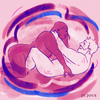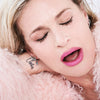UNLEASHING BI-BLISS: NAVIGATING BISEXUAL SEX EDUCATION AND THE PLEASURE POTENTIAL OF EXCITING AND INCLUSIVE TOYS

Like many bisexuals, I didn’t know how to interpret my sexuality until I was an adult. My adolescence was confused, angsty, and worst of all, totally lacking in any meaningful sexual education.
Don’t get me wrong, I got the heteronormative sex ed lectures in high school, but they only taught me about sex with men through a thick layer of abstinence preaching. My desire to sleep with women felt wrong because no one was discussing it. The education system - which was supposed to tell me what was scientifically valid - wholly ignored my sexuality.
When I finally saw homosexuality mentioned offhand in a psychology textbook I was ecstatic, but there was still nothing about being bi. My gay friends would joke that being bi, “was just for people who don’t know they’re gay yet.” My straight friends either called bi girls sluts or treated them like a novelty for their own sexual gratification.
So was I gay? Was I hornier than normal? Was I just a pervert? It took me years of higher education to untangle that web of insecurity because when it comes to sex ed, we learn as much from what isn’t taught as we do from what is.
COMBATING BI-INVISIBILITY
The biggest problem with bisexual sex ed is bi-invisibility (AKA bi-erasure). This means that bisexuals are often ignored or misrepresented in both media and academia and, in some cases, people don’t believe we even exist.
This is a self-perpetuating issue. United States census data from 2021 found that 4.4% of adults are bisexual, though younger generations like Gen Z - who are more educated and accepting of queer sexualities - say as many as 15% are. However, bisexuals are far less likely to come out than homosexuals.
Because bisexuals don’t feel safe coming out, we don’t truly understand how many people are bi. This leads us to think there are fewer bi people than are are, which contributes to underrepresentation.
The future of bisexual sex ed involves at least addressing and defining bisexuality, preferably in adolescence when queer kids are particularly susceptible to insecurity and bullying. It seems like a simple change, but learning that bisexuality is real transforms the way people understand themselves or the bi people in their lives.
Knowing that their sexual feelings are valid does just help bisexuals come out and be their true selves; it also helps stop negative myths and stereotypes.
DISPELLING HURTFUL MYTHS
I don’t know if it’s ever been easy for anyone to come out of the closet. Lesbians may remember being written off as “going through a phase” or told that they hadn’t found the right man yet. Gay men may have been treated like sexual predators or even told that they were gay because their mothers were too affectionate.
These silly myths - and many others - are easy for a hetero person to say but can be devastating for a queer person who’s seeking acceptance. Huge strides have been made to dispel these myths, and we hear them less and less each year.
Bisexual acceptance has come slower, however, especially since they can face discrimination from heterosexuals and homosexuals. For bi people, the harmful myths come from the fact that they aren’t monosexual (the attraction to one sex only) like heterosexuals and homosexuals are. This makes bi people harder to understand and easier to discriminate against.
People often see bisexuals - especially bi women - as promiscuous or sexually deviant. A bisexual woman is not a sexual novelty or accessory. Many couples assume that bisexual women want to be a part of their three-way. Many straight women think they can experiment with a bi woman without considering her feelings. Many straight men refuse to date bi women because they would feel too jealous.
In sexual education, we are starting to see curriculums that specifically address negative stereotypes about homosexuals. These efforts need to be more inclusive. They need to state at least that bisexuality is not a phase, bisexuals are not more likely to cheat on their partners, they do not necessarily have a higher drive, and that bisexuality and polyamory are not the same.
BISEXUAL HEALTH CONCERNS
The myths surrounding bisexuals can lead to “double discrimination” that can alienate them from both straight and queer communities. It’s no surprise, then, that bisexuals show more severe symptoms of depression and anxiety than lesbians or gay men.
They are also more likely to abuse substances, engage in self-harm, or attempt suicide. This trend isn’t fully understood yet, but it’s likely related to the aforementioned discrimination from both straight and gay communities.
The future of sex ed must address these issues - preferably in adolescence when these behavior patterns are typically formed. Not only should sexual education cover the mental health risks that affect bisexuals, but it should also provide resources for seeking help.
Ultimately, though, education needs to emphasize that bisexuals are not an oddity or an “other.” The scope of their sexuality may be wider than most, but that does not mean they should be viewed or treated as primarily sexual. Monosexuals may not be able to empathize with all of their struggles, but that doesn’t mean those struggles don’t exist.
EMPOWERING BISEXUAL PLEASURE
While I am 100% an advocate of discussing pleasure in sexual education, I’m aware that that’s not going to happen on a large scale anytime soon. Still, sexual pleasure (and especially masturbation) can help relieve stress, improve mood, boost self-esteem, and more.
Bisexual women don’t always have the security of opportunity to experiment freely, so here are some toys you can use with or without a partner to practice self-love and pleasure.
LUXURY MASSAGE CANDLE
Massage Candle I know what you’re thinking - how is a candle a sex toy? I promise there’s a method to the madness here.
Sex is as psychological as it is physical, yet we often skip to the physical. Adding the sensation of a lovely smell can relax you and help you connect with your partner or yourself emotionally and mentally.
It’s essentially a foreplay tool, but it can help transform habitual sex or masturbation into a more fulfilling experience.
HERA FLEX RABBIT VIBRATOR
This vibrator is soft and flexible so you can shape it uniquely to your body. It’s a fantastic toy for learning more about what you love and stimulating yourself both internally and externally.
If your partner has a penis, it’s also flexible enough to fit around their shaft and stimulate them too.
MIMI SOFT CLITORAL VIBRATOR
This little toy is about the size of a pebble, so it’s perfect for exploring clitoral pleasure. Its focused vibrations can help you explore other erogenous zones like the nipples, perineum, or pubic mound. You can even use it for delicate massages.
NUO VIBRATING BUTT PLUG
Anyone can enjoy anal play, but few understand how healthy it can be. In addition to stimulating your pelvic nerves, it can help relax your pelvic floor muscles and increase blood flow. This can make it easier to feel pleasure and intensify your orgasms - not to mention that it can feel great in your rectum.
This toy works regardless of sex, so it can pleasure both partners. You can use it to prepare for anal sex or to create sensations that enhance sex of any kind.
Exploring sexual pleasure doesn’t just make us feel good. It teaches us more about ourselves, our sexuality, and our needs - all of which help us better understand each other.
ABOUT THE AUTHOR
 Dr. Aliyah Moore (she/her)
Dr. Aliyah Moore (she/her)Dr. Aliyah Moore (she/her) is a certified sex therapist, writer, and sexpert at SexualAlpha. She’s passionate about educating and empowering women to embrace their sexuality and identity. Read more about her story and experience on her website: AliyahMoore.com





